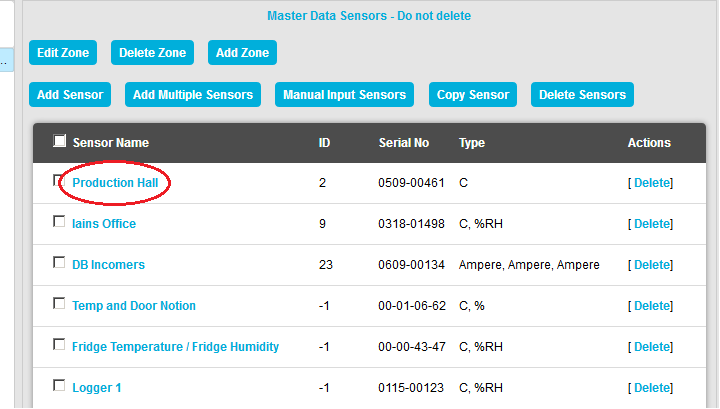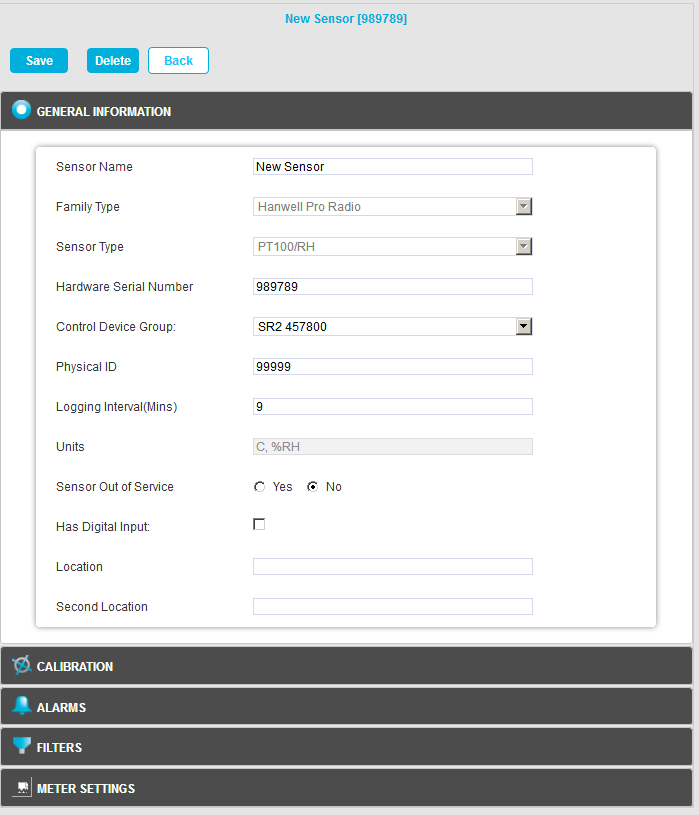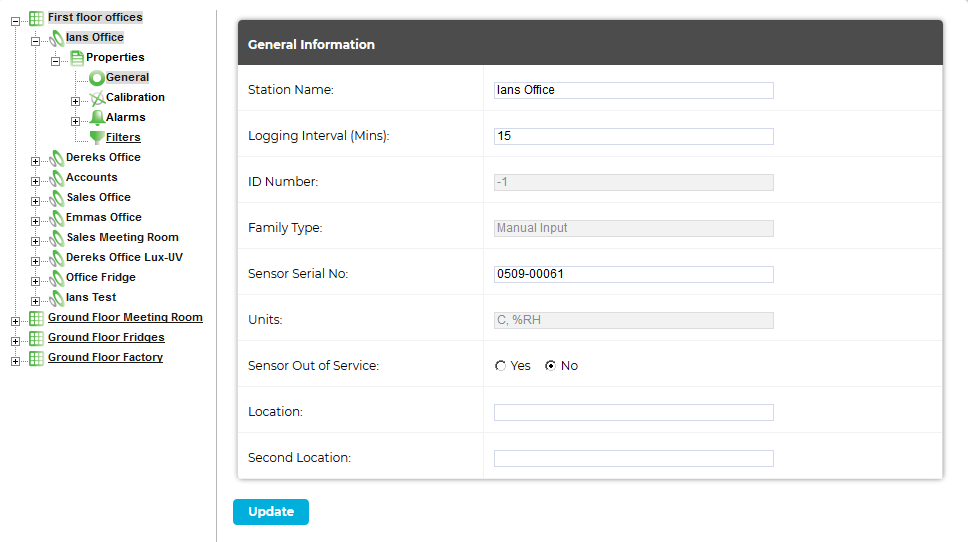Navigation:
System Configuration Sensors > Configuring Sensors >> General Properties
Sensor General Properties
Editing the Sensor General Properties
All Hanwell Sensors/Transmitters come with Default Calibration Values, which are created during installation.
•These are only suggested values and can be changed to suit the User's requirements.
1.Access the General icon in the left-hand menu of the Editing and Configuration window as outlined in Accessing Sensor Properties. 2.Click on the General underscored icon to open the General Information window for the selected Sensor/Transmitter. See Figure 801 below: Figure 801
•The following Sensor General Properties can now be edited: Station Name: Though the Station Name can be changed, be aware that changing the name may be confusing for other Users as the Station Name normally relates to the physical location of the Sensor/Transmitter. ➢Changing the Station Name no longer starts a new data file. Logging Interval (Mins): This is only required if you wish to set the Sensor/Transmitter to log. ➢The time entered here will set the data logging period in the data logger. ➢If logging is not required, leave as default. ➢Enter the time in the format: 15.This example will set the logging interval to 15 minutes. ID Number This is the ID number that the Sensor/Transmitter transmits to identify it to the System. ➢This number, once set, should not be changed. Family Type: This determines the type of transmission protocol that the Sensor/Transmitter is using; this field is here to cater for future developments. The type field is propagated when the Sensor/Transmitter is added to the System. Sensor Serial No: This is set when the Sensor/Transmitter is added to the System and will be completed either automatically by radio or via the EMS Management Application. Units: This is the measurement units for each of the channels for the Sensor/Transmitter. ➢These cannot be changed here as they are set by the Sensor/Transmitter install. Sensor Out of Service: This feature allows you to temporally take a sensor out of service. This is useful if the Sensor/Transmitter is measuring something that is turned off for a period and monitoring is not required. ➢It avoids alarms being generated while the Sensor/Transmitter is not required. ➢Out of Service Sensors are displayed with blue text in the Live View. Location: Second Location: The Location and Second Location: fields allow you to put notes against the Sensor to assist with physically locating the Sensor/Transmitter within a building. ➢These are aide-mémoires only, serve no operational function within the software and are not mandatory. 3.Once you are happy with any changes select Update. |
Access the Zone's Edit Mode window for the required Sensor, as outlined in Accessing Sensor Properties:
1.Either:
i.In the left-hand list of the Zone's Edit Mode window, click on the small 'arrow' symbol to display a list of the Sensors associated with the Zone. See Figure 802 below:
Figure 802

ii.In the left-hand list, click on the required Sensor's icon ![]() .
.
Or:
In table in the Zone's Edit Mode window, click on the required Sensor's name in the Sensor Name column. See Figure 803 below:
Figure 803

•The Edit Mode window for the selected Sensor is displayed with the GENERAL INFORMATION pane displayed by default. See Figure 804 below:
Figure 804

•The following Sensor General Properties can now be edited:
•Sensor Name
Here you can type a name for the Sensor that means something in relation to either the type of measurement that the Sensor is making or the location, for example, RH/T Room 1 or Room 1.
For this example we are going to call our Sensor, 'RH/T Room 1'.
The ‘family’ for the Sensor you are adding.
Select from:
•Hanwell Pro Radio
•iSense
•Hanwell IceSpy Radio
•Manual Input
•Hanwell Pro Logger
•Hanwell IceSpy Legacy Scout
•Selsium
•ML/RL2000
Select the type of Sensor you are adding from the drop-down menu.
Descriptions of all of the available Sensor types can be found on our website.
For this example we will add a Temperature and Humidity Sensor. The standard temperature and humidity Sensor can be found in the list as Thermistor/RH.
| Note: | To add a Single Channel Linear Sensor, use the standard Dual Channel Linear Sensor hardware, but add it to the System as a Single Channel Linear Sensor. |
This is the Transmitter's Serial Number and can be found on the back of the transmitter.
You can either:
Enter the Serial Number in the dialog box in the following format: 0113-00001
Or:
Enter a 0 (zero).
If a 0 (zero) is entered, the Serial Number will be filled in automatically by the EMS Management Application when the Sensor is synchronised. For details see Document: IM6000 EMS Remote Management Tool User Guide.
•The Control Device Group is the wireless receiving device that will receive the data from the transmitters.
•The Control Device Group is selected from the drop-down menu.
•Select the Control Device Group which corresponds to the Site and is compatible with the wireless transmitters used at that Site.
•For more details see the Adding Control Devices section.
•For this example, we are going to select Hanwell.
•Physical ID
•This is the Unique Sensor ID, it can be in the range 1 to 255.
•For this example we are going to select Sensor 1.
•If the Physical ID is already used by another Sensor, the System will suggest the next available ID.
•Internal Logging Interval (Mins)
•The time, in minutes, between the Sensor's Logging/Parameter Sampling events.
•Send Interval
➢For certain Families of Sensor (for example iSense) this Value sets the interval between times when logged data is sent to the Hanwell Remote Data Service.
| CAUTION: | Changing the Send Interval and Internal Logging Interval (Mins) values in EMS (Edit Mode) for an iSense Unit will flush any unsent data from the iSense Unit’s memory. |
The Optional Details are:
•Units
This is the measurement Units for each of the channels for the Sensor/Transmitter.
•These cannot be changed here as they are set by the Sensor/Transmitter install.
•Sensor Out of Service
This feature allows you to temporally take a Sensor out of service. This is useful if the Sensor/Transmitter is measuring something that is turned off for a period and monitoring is not required.
•It avoids alarms being generated while the Sensor/Transmitter is not required.
•Out of Service Sensors are displayed with blue text in the Live View.
•Has Digital Input
Checking this box registers that at least one of the Sensor's channels monitors a digital signal.
•Location
Second Location
The Location and Second Location fields allow you to put notes against the Sensor to assist with physically locating the Sensor/Transmitter within a building.
•These are aide-mémoires only, serve no operational function within the software and are not mandatory.
2.Once you are happy with any changes click on Save.
•Click on the Back button to cancel any changes to the Sensor's General Properties.

